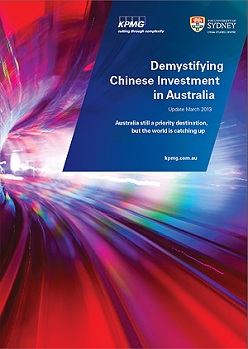The latest research into Chinese direct investment by KPMG and the University of Sydney China Studies Centre - Demystifying Chinese Investment in Australia: Update March 2013 - reveals some new and potentially significant changes to the pattern of Chinese outbound direct investment (ODI) in Australia in 2012 compared to previous years. These changes occurred across industry sector, geography and investor type.
The report also found Australia is facing increasing competition from other countries for Chinese investment dollars. Australia maintained its top ranking as the most significant recipient of Chinese ODI over the last eight years since large-scale investment of this kind began in earnest in 2005, but it is losing its dominant status.
"Chinese investment is geographically diversifying, and the USA and Canada in particular are catching up with Australia," Professor Hans Hendrischke of the University of Sydney China Studies Centre, said.
"While Australia's accumulated Chinese direct investment is still ahead of its main international competitors, there is no denying that the rest of the world is hot on our heels and aggressively competing for Chinese capital."
Canada achieved top position for Chinese investment for the 2012 calendar year, due to the completion of one enormous transaction - the US$15.1 billion CNOOC-Nexen oil and gas company deal.
By the end of 2012, total accumulated investment reached US$51 billion in Australia, followed by US$50.7 billion in the USA and US$36.7 billion in Canada. Other major recipients included Brazil and Russia. The largest investment destinations in Europe and Africa are the United Kingdom and Nigeria respectively.
Although short of the historic peak of US$16.2 billion in 2008, Chinese direct investment inflows into Australia in 2012 increased 21 percent from 2011 to reach US$11.4 billion (AU$11 billion) across 27 transactions, up from US$9.4 billion in 2011 and US$3.7 billion in 2010.
"These numbers confirm that Australia is still a priority destination due to our vast supply of high quality natural resources, stable and reliable institutional systems and clean, green and fresh image for lifestyle. While mining and resources still dominate investments, we're seeing greater diversification towards LNG, agribusiness, renewable wind energy and real estate," Doug Ferguson, Head of KPMG's China Practice in Australia, said.
Ferguson expects to see continued growth in areas recognised as world's best practice including engineering and architecture, renewable energy, specialist environmental services and food safety and processing.
Geographically, Western Australia and Queensland continued to grow as top destinations for investment, highly concentrated on mining and resources. Encouragingly, the report found NSW and Victoria's engagement with Chinese companies was increasingly diversifying across various sectors.
Notably, the proportion of investments by privately owned Chinese companies rose during 2012, while the share of capital invested by Chinese State-Owned Enterprises (SOEs) declined across the year. Chinese non-state (ie private) investors completed 26 per cent of all deals by number, and 13 per cent by deal value.
These results again differ from historical trends which indicate SOEs accounted for 94 per cent by value and 80 per cent by number of deals between September 2006 and December 2012.
"We are starting to see the next wave of Chinese investment in Australia being made by privately owned companies and this trend will continue under the new investment visa program which opens the door for high net wealth Chinese investors," Ferguson said.
"However, in view of the large size of deals in Australia, the dominance of SOEs is likely to continue as these companies dominate the energy, mining and infrastructure sectors at home in China and have strong central government support to invest abroad."
The report flags that while Australia continues to be an attractive investment destination, as Chinese companies diversify global investments and international competition for Chinese capital increases, Australia's relative share of Chinese investment is decreasing.
Australia's traditional advantages in natural resource endowments, stable and reliable institutional and legal systems and low sovereign risk remain strong in competition with developing countries as suppliers of resources and energy, but count for less when competing with the USA and Canada.
Australia's future advantages will additionally rely on innovative commercial engagement and deeper service integration with Chinese investors.
"We urgently need to develop new and creative competitive strategies to maintain our position as a preferred investment partner for China, for example building a China-capable workforce from board level through to university students," Ferguson said.
"We must look for opportunities to co-operate with Chinese corporates and financial services companies to jointly compete for, win and successfully deliver major projects both in Australia and together in the region.
"Chinese investors are rapidly adapting to the Australian investment and regulatory environment, and recognise that they need to do more to communicate their strategic intentions and allay public concerns.
Importantly, they want to see commitment, action and follow through from Australian governments and the corporate sector to successfully deliver existing Australian projects and new investments."









-160x160-state_article-rel-cat.png)



-160x160-state_article-rel-cat.png)
-160x160-state_article-rel-cat.png)
-160x160-state_article-rel-cat.png)








